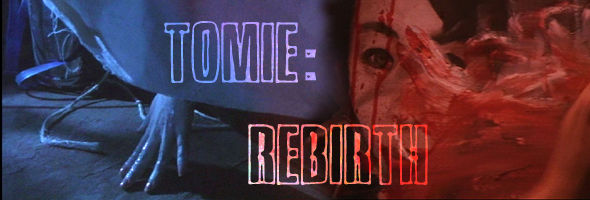
Color, 2001, 101m. / Directed by Takashi Shimuzu / Starring Miki Sakai, Satoshi Tsumabuki, Masaya Kikiwada / Ventura (US R1 NTSC) / WS (1.78:1) (16:9) / DD5.1 Color, 1999, 95m. / Directed by Mitsuishi Fujirou / Starring Sayaka Yamaguchi, Yôsuke Kubozuka / Ventura (US R1 NTSC), Daiei (Japan R2 NTSC) / WS (1.78:1) (16:9) / DD2.0
The opening sequence, a gruesome twist on the prior film's curtain raiser, finds a group of surgeons operating on a woman with a stomach disorder, only to find an orange eye staring back at them from inside her belly... followed by a full human head popping out on the operating table. The head surgeon, Dr. Morita (Sugata Shun), (who absorbed some tainted blood during the procedure, disappears and leaves his young daughter, Yumi (Yamaguchi), desperate to learn his whereabouts. Now grown back to full size, Tomie hooks up with a young man in the countryside and soon drives him to madness, leading him to slice off her head and bury it. However, you can't keep a
A solid example of visceral Asian horror, Tomie: Replay works up some strong chills thanks to a succession of bizarre, unsettling visuals and expert timing, delivering gory shocks when necessary while leaving other nasty activity wisely in the viewer's imagination. The repeated imagery of Tomie's disembodied head screaming, being set on fire, and growing a spinal cord inside a tank (memorably played back on video near the finale) makes an indelible mark, creating a more haunting and engaging experience than the first Tomie. The acting is the garden variety "look panicky and concerned while urgently delivering ludicrous dialogue" style known and loved by many Japanese horror fans; devotees of young Asian pin-up actresses will find plenty to admire here,
Appropriately, a better film gets a better transfer thanks to Ventura's DVD (which, unlike its Japanese Region 2 counterpart, contains optional English subtitles). The omnipresent blues and oranges look nice and vivid, while blacks are a bit more stable and deep than usual for what still seems to be a transfer culled from a Japanese source. Bonus points for making the transfer anamorphic, unlike the first film. The audio sounds fine, delivering some nice atmospheric surround effects to increase the tension in numerous scenes (especially the severed head bit in the woods). Extras include a gallery of manga art from the popular series and trailers for all five Tomie films.
Color, 1999, 95m. / Directed by Ataru Oikawa / Starring Mami Nakamura, Yoriko Douguchi / Ventura (US R1 NTSC) / WS (1.78:1) / DD5.1, Universe (HK R0 NTSC) / WS (1.78:1) / DD2.0
The basic concept of Tomie is certainly a grabber, and the opening sequence is appropriately chilling and intriguing. Unfortunately the film is unable to sustain a consistent tone of unease, opting instead to let characters sit quietly in rooms and murmer about the plot rather than doing anything about it. The subdued approach works fine to a certain point, but eventually most viewers will feel impatient waiting for a payoff that only partially arrives. The dark, mysterious visual quality of the film is nicely maintained and certainly atmospheric, with a reliance on the color orange resulting in a feverish, dreamlike ambience during Tsukiko's flashbacks. However, style can only carry the film so far before the realization sets in that this is basically a long, middling
Ventura's DVD offers a serviceable non-anamorphic transfer with those telltale heightened black levels, indicating this was sourced directly from a Japanese video master. Unlike the Hong Kong NTSC disc which only features a standard surround track, the US disc contains a restrained but effective 5.1 mix which boosts one of the film's greatest assets, a grumbling and often disturbing electronic score. The optional English subtitles are a big improvement over the incoherent HK subtitles, which often rendered the film laughable.
The US disc contains a moderate but welcome amount of bonus material, kicking off with with trailers for all five entries in the Tomie series (most of which look far more exciting than the first feature). Also included is a making-of documentary featuring interviews with Ito (who has a cameo in the film and tellingly reveals that as a youth he had a paralyzing fear of women) and Oikawa.
Mostly on par with the second film in the Japanese-schoolgirl-from-hell Tomie series and certainly better than the first, this third outing for the regenerating psycho sports some added marquee value thanks to director Takashi Shimuzu, whose sublimely creepy Ju-on series became a Japanese cult sensation.
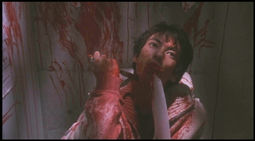 This time out, young art student Hideo (Shûgo Oshinari) paints an unnerving portrait of Tomie (Sakai), who whispers that she loves him. Inexplicably, he reacts by stabbing her to death with a painting trowel. Two friends, Takumi (Tsumabuki) and Shunichi (Kikiwada), arrive on the scene and help him dispose of the body. To cheer him up, the boys take the unwitting murderer to the nearest bar for a party... but a mysterious girl named Tomie shows up, bearing a few odd physical resemblances to the dead girl in the ground. Soon Hideo winds up a bloody mess in the bathroom stall, and his two compatriots are assaulted with a series of bizarre events in which Tomie possesses other girls' bodies, winds up a yammering severed head with claw-like arms, and taunts them no matter how often they kill her.
This time out, young art student Hideo (Shûgo Oshinari) paints an unnerving portrait of Tomie (Sakai), who whispers that she loves him. Inexplicably, he reacts by stabbing her to death with a painting trowel. Two friends, Takumi (Tsumabuki) and Shunichi (Kikiwada), arrive on the scene and help him dispose of the body. To cheer him up, the boys take the unwitting murderer to the nearest bar for a party... but a mysterious girl named Tomie shows up, bearing a few odd physical resemblances to the dead girl in the ground. Soon Hideo winds up a bloody mess in the bathroom stall, and his two compatriots are assaulted with a series of bizarre events in which Tomie possesses other girls' bodies, winds up a yammering severed head with claw-like arms, and taunts them no matter how often they kill her.
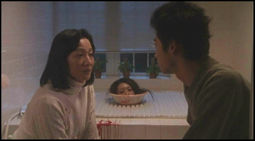 More comic than usual, this Tomie tale features some memorable sequences blending the quirky and the grotesque after a fairly lumbering middle act in which virtually nothing happens. This film is tailor-made for DVD, as impatient viewers can watch the first half hour, then skip on to the 55-minute mark or so without missing much of consequence. Obviously the slow pacing is something the series had already established by this point, but in this case the slow bits could charitably be described as glacial. Fortunately Shimuzu's unerring eye for striking compositions and subtle, chilling visuals carry the film over the slow patches, and when he finally breaks out the fireworks, the results are striking indeed. None of the actors get much of a chance to stretch themselves, though Sakai (sans body) gets a few nice moments during a powerhouse showdown with the world's most deluded, domineering mother.
More comic than usual, this Tomie tale features some memorable sequences blending the quirky and the grotesque after a fairly lumbering middle act in which virtually nothing happens. This film is tailor-made for DVD, as impatient viewers can watch the first half hour, then skip on to the 55-minute mark or so without missing much of consequence. Obviously the slow pacing is something the series had already established by this point, but in this case the slow bits could charitably be described as glacial. Fortunately Shimuzu's unerring eye for striking compositions and subtle, chilling visuals carry the film over the slow patches, and when he finally breaks out the fireworks, the results are striking indeed. None of the actors get much of a chance to stretch themselves, though Sakai (sans body) gets a few nice moments during a powerhouse showdown with the world's most deluded, domineering mother.
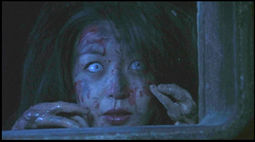 Ventura's DVD reflects the rough nature of the original source material, which looks more impoverished than the prior film and suffers from some very soft photography. The washed-out black levels don't help much, either; even on a 16:9 display, the results are middling at best. Considering the relatively low budget nature of the films, though, it's doubtful a better video transfer will come along anytime soon. The 5.1 audio is fairly restrained given the quiet nature of most of the film, though the mix does employ some nicely effective ambient surrounds at a few key points. It can't compare to Ju-on for sonic manipulation, but not a bad job. Extras include the usual batch of Tomie trailers (the next one was shot directly on video, alas) and a batch of storyboards and FX shots, but the best bonus by far is a making-of featurette in which Shimuzu and the young leads discuss the making of the film. Mostly everyone emphasizes the director's belief that horror films are funny and scary in equal measure, with Sakai claiming she was so scared by the script she couldn't sleep. Somebody should show her Ringu sometime...
Ventura's DVD reflects the rough nature of the original source material, which looks more impoverished than the prior film and suffers from some very soft photography. The washed-out black levels don't help much, either; even on a 16:9 display, the results are middling at best. Considering the relatively low budget nature of the films, though, it's doubtful a better video transfer will come along anytime soon. The 5.1 audio is fairly restrained given the quiet nature of most of the film, though the mix does employ some nicely effective ambient surrounds at a few key points. It can't compare to Ju-on for sonic manipulation, but not a bad job. Extras include the usual batch of Tomie trailers (the next one was shot directly on video, alas) and a batch of storyboards and FX shots, but the best bonus by far is a making-of featurette in which Shimuzu and the young leads discuss the making of the film. Mostly everyone emphasizes the director's belief that horror films are funny and scary in equal measure, with Sakai claiming she was so scared by the script she couldn't sleep. Somebody should show her Ringu sometime...
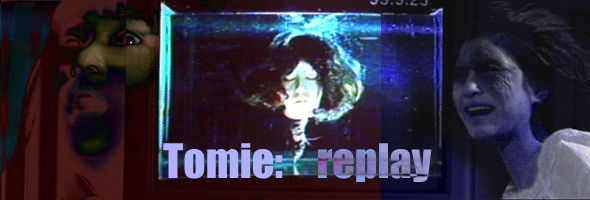
More overtly horrific and less stylized than its predecessor, this second outing for the ultimate regenerating female nightmare feels like a peace offering to manga and horror
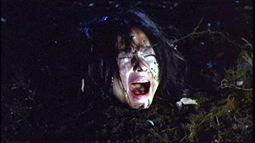 fans who were less than thrilled with the stodgy pacing of the first Tomie. Instead of sickly mood lighting and quiet unease, now we have an icy blue nightmare filled with severed heads, wheelchair terror, axe mayhem, and other assorted horror elements piling up to a satisfying, grotesque climax.
fans who were less than thrilled with the stodgy pacing of the first Tomie. Instead of sickly mood lighting and quiet unease, now we have an icy blue nightmare filled with severed heads, wheelchair terror, axe mayhem, and other assorted horror elements piling up to a satisfying, grotesque climax.
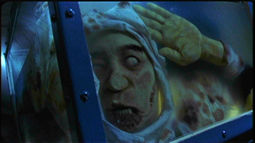 good monster down, and soon Tomie's back again to return to the hospital to clean up unfinished business.
good monster down, and soon Tomie's back again to return to the hospital to clean up unfinished business.
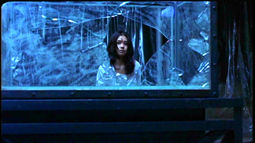 and Yamaguchi acquits herself well as the main scream queen even when spending the final act confined to a wheelchair.
and Yamaguchi acquits herself well as the main scream queen even when spending the final act confined to a wheelchair.
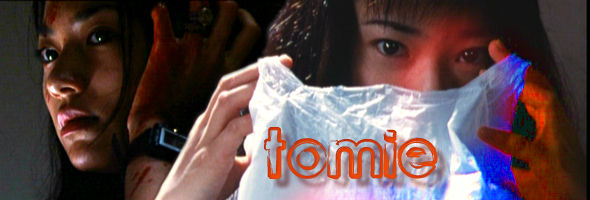
This unusual entry in the growing Japanese canon of stylish modern horror films lies somewhere between their patented icy psychological chills (Ring, et al) and those more disreputable
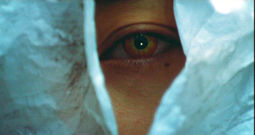 gorefests, resulting in a fish-nor-fowl product that met with a less than enthusiastic response overseas. However, the film (and its point of origin, a manga from Juni Ito) proved successful enough to spawn four sequels and a moderate fan following. Sort of a gothic, female version of Highlander, the story begins when a teenage boy walks along a busy street and casually disposes of a plastic bag, inside of which a living human eye can clearly be seen. Cut to our heroine, young art student Tsukiko (Nakamura), who's suffering from amnesia and baffling nightmares after suffering a violent accident. She seeks help from a hypnotherapist (Douguchi), whose office looks more like a tanning salon, and soon the truth begins to surface. Tsukiko mentions the name "Tomie," a school friend who was murdered three years earlier with Tsukiko and Tomie's boyfriend present at the scene. An investigating detective (Tomorowo Taguchi) reveals that "Tomie" has actually been a recurring murder victim for decades, continuously provoking murder sprees before turning her boyfriends on herself. Most distressingly, Tsukiko's apartment is populated by some very strange inhabitants, including a misshapen girl in the supposedly empty unit below; could a new Tomie be growing, intent on another bout
gorefests, resulting in a fish-nor-fowl product that met with a less than enthusiastic response overseas. However, the film (and its point of origin, a manga from Juni Ito) proved successful enough to spawn four sequels and a moderate fan following. Sort of a gothic, female version of Highlander, the story begins when a teenage boy walks along a busy street and casually disposes of a plastic bag, inside of which a living human eye can clearly be seen. Cut to our heroine, young art student Tsukiko (Nakamura), who's suffering from amnesia and baffling nightmares after suffering a violent accident. She seeks help from a hypnotherapist (Douguchi), whose office looks more like a tanning salon, and soon the truth begins to surface. Tsukiko mentions the name "Tomie," a school friend who was murdered three years earlier with Tsukiko and Tomie's boyfriend present at the scene. An investigating detective (Tomorowo Taguchi) reveals that "Tomie" has actually been a recurring murder victim for decades, continuously provoking murder sprees before turning her boyfriends on herself. Most distressingly, Tsukiko's apartment is populated by some very strange inhabitants, including a misshapen girl in the supposedly empty unit below; could a new Tomie be growing, intent on another bout 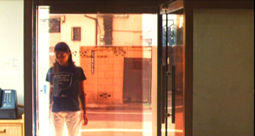 of violent mayhem?
of violent mayhem?
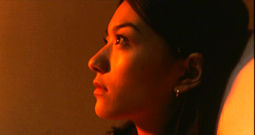 ride with a few nasty nudges involving severed limbs and regenerating schoolgirls to keep horror fans awake.
ride with a few nasty nudges involving severed limbs and regenerating schoolgirls to keep horror fans awake.
